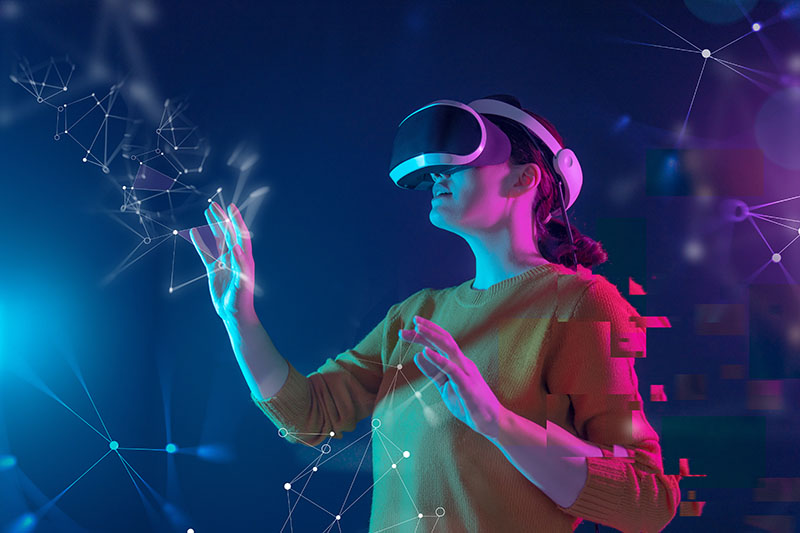Ever since Mark Zuckerberg announced that he wanted to build a metaverse, the subject has been in vogue, without necessarily being new. What were the observable premises that led to the idea of a mainstream metaverse? And for that matter, is the metaverse unique and indivisible? At a time when anyone can create content online, what are the stakes for companies and brands in an entirely virtual universe? What are the boundaries of these new virtual universes? Can the metaverse be considered a territory in its own right? And what rules apply to the territoriality of licenses and intellectual property protection?
What is the metaverse?

Regularly described as “the Internet of the future”, a metaverse is a virtual world in 3 dimensions, where users can interact with each other and modify their environment. Users are connected to the Internet via a screen or virtual reality headset.
Early examples of the metaverse include the Second Life platform, which enjoyed its heyday in 2006-2007, when anyone could create their own avatar for free, and the various versions of The Sims game. So it’s not quite right to speak of a single metaverse, but of multiple versions that aren’t necessarily compatible with each other. If the metaverse is currently in the news, it’s because Mark Zuckerberg has announced that he’s working on his own project with Meta (the new name of Facebook’s parent company), and a number of players have expressed an interest in the subject, whether with Meta or through their own projects.
Following the example of Epic Games (developer of the game Fortnite), some are hoping for an open metaverse where the different universes would be interoperable. Others seek above all to transpose their usage into a proprietary metaverse, as Microsoft would like to do for the enterprise and the world of work with avatars in Teams.
Why is the metaverse possible now?
While metaverses are not in themselves new projects (games like Roblox or Fortnite can be considered metaverses with very large audiences, without being completely mainstream), a convergence of technologies and uses can quickly give them popularity.
Everything seems ready for the perennial integration of these universes into our lives:
- Virtual reality headsets are still a niche product, but they are now accessible to the general public and can be manipulated with less and less technical knowledge.
- Augmented reality has taken hold in everyday life with games like Pokémon Go, Instagram filters, and connected glasses like Snap’s Spectacles that promise to add an extra layer of magic to our surroundings.
- Immersive video games and RPGs (Role Playing Games) create worlds of almost infinite possibilities. Users create and sell their own artifacts, buy moves, outfits and other items created by developers. Animal Crossing and Fortnite spring to mind.
- The recent rise of NFTs (Non Fungible Tokens) has anchored the purchase of dematerialized products, their exchange, and their creation by companies. Universes such as Axie Infinity now rely exclusively on NFTs to create virtual real estate projects where transactions take place in cryptocurrencies.
- Successive confinements have accelerated long-distance exchanges. Internet users have become accustomed to videoconferencing, both personally and professionally.
- A real appetite for personalized avatar creation, encouraged by numerous games, applications and communication tools (emojis, messaging avatars, etc.).
What uses can be transposed to the metaverse?
At first glance, the answer is simple: all of them!
If metaverses can recreate any universe, we should be able to do anything in them, a bit like in Matrix. The uses already identified seem to confirm this idea: real estate transactions in Axie Infinity, concerts in Fortnite, visiting friends in Animal Crossing, handbag or art collections in NFT, virtual meeting rooms, even vacations with a few minutes’ teleportation to the Bahamas at low cost with a virtual reality headset… Everything is possible in a metaverse version, since real-world interactions are transposed.
One of the great unknowns of metaverses is the choice between virtual reality and augmented reality. Will players continue to develop metaverses as universes uncorrelated with reality, or will they turn them into an overlay of reality, where users can buy objects visible only through a specific screen or glasses?
Is the company a user like any other?
The multiplication of platforms dedicated to small entrepreneurs (Etsy and various marketplaces) and the possibility for individuals to become media and content creators tends to increasingly erase the online differentiation between businesses and individuals. Moreover, platforms like Instagram have opened up their augmented reality tools (for creating filters) to all, blurring this difference even further.
Yet companies have a card to play in moving from B-to-C marketing to B-to-Avatar marketing. Everyone has access to the same creative tools. Brands have launched loyalty programs with NFT, clothing for avatars, and unique dematerialized objects to hang in your virtual home.
Metaverse and intellectual property: a real challenge for brands and companies
If NFTs seem to prevent counterfeiting by certifying the originality of objects thanks to the blockchain, how can you ensure that one of your products, your logo or even your entire universe is not recreated virtually and identically within a metaverse? How can you guarantee that no one will invest in the metaverse before you with your own products? What industrial property rules apply, as is the case today online, since the metaverse is an extension of the Internet as we know it ?
For brands, the metaverse(s) represent very real stakes. Given the rapid deployment of such an innovation – we have no doubt that Mark Zuckerberg will be pulling out all the stops to set up his new virtual Eldorado! -The race against time to register patents is on. Companies are well advised to seek the support of an IP consultant. Following the announcement of Facebook’s metaverse, some brands have already started to get busy. A pioneer in many fields, the Nike brand wasted no time in filing trademark applications with the United States Patent and Trademark Office (USPTO ) for several virtual products.
Also read: Patent or Soleau envelope to protect software?
Challenges and opportunities for intellectual property law and protection in the metaverse
From a legal point of view, the metaverse raises a number of questions about trademark, copyright and image rights, such as :
- intellectual property and control of authorization to use protected content in a digital environment. With a metaverse, anything is possible. So how can you limit and guarantee the use of your brand or product?
- the territoriality of licenses. Intellectual property titles are defined by country. As a result, is a metaverse considered the same as a physical territory? A zone beyond borders? While a number of jurisprudences have already been issued on the subject, the virtuality of this world makes it difficult to assess objective criteria.
- control of counterfeiting and UGC (User Generated Content), or content created by users around a brand. Without limits, and if crossing the borders between different metaverses is not a problem, users can use your brand, its attributes or its products whenever and however they want. This makes the role of intellectual property licensing all the more important. Brands and companies have a vested interest in controlling and defining the framework of use if they wish to retain control over their brand image and reputation. There may well be points of friction between content producers and brands.
Metaverse(s), patents and intellectual property: now what?
While some consider that we’re already partly living in the metaverse, investment in metaverses shows that the subject is set to go mainstream and gain momentum in the coming years. By integrating the blockchain and its certificates, developers are able to track transactions and the originality of each artifact sold. However, for the time being, it seems difficult to say what industrial property issues will emerge as new universes emerge, and according to what criteria.
Faced with these new paradigms, brands and companies need to be agile. Support from intellectual property advisor advisor is necessary, if not indispensable.
Likewise, they will surely need to recruit new Argus (editor’s note: mythological giant with a hundred eyes) to keep a close eye on metaverses. Indeed, although certain technologies such as NFT exist, the detection of intellectual property infringement remains a complex problem. Many companies need to diagnose whether they are legally ready for this challenge. We have no doubt that new monitoring tools, and even new professions and rules, will be needed to cope with these developing virtual universes.
